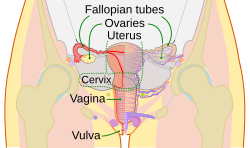Uterine appendages
Appearance
| Uterine appendages | |
|---|---|
 Schematic frontal view of female anatomy | |
 Uterus and right broad ligament, seen from behind. (In this orientation, the contents "in front" of the broad ligament are posterior to it.) | |
| Details | |
| Identifiers | |
| Latin | adnexa uteri |
| MeSH | D000290 |
| Anatomical terminology | |
The uterine appendages (or adnexa of uterus) are the structures most closely related structurally and functionally to the uterus.
Terminology
[edit]They can be defined in slightly different ways:
- Some sources define the adnexa as the fallopian tubes and ovaries.[1]
- Others include the supporting tissues".[2]
- Another source defines the appendages as the "regions of the true pelvis posterior to the broad ligaments".[3]
- One dictionary includes the fallopian tubes, ovaries, and ligaments (without specifying precisely which ligaments are included).[4]
Clinical significance
[edit]The term "adnexitis" is sometimes used to describe an inflammation of the uterine appendages (adnexa).[5] In this context, it replaces the terms oophoritis and salpingitis.
The term adnexal mass is sometimes used when the location of a uterine mass is not yet more precisely known.
63% of ectopic pregnancies present with an adnexal mass. Depending on the size of the mass, it could be a medical emergency.
The term "adnexectomy" in gynaecology is often used for salpingo-oophorectomy (removal of both: fallopian tubes and ovaries).
Additional images
[edit]-
Ovary
See also
[edit]References
[edit]- ^ Abele, H (2014). Atlas of gynecologic surgery. Stuttgart: Thieme. ISBN 9783136507049; Access provided by the University of Pittsburgh
{{cite book}}: CS1 maint: postscript (link) - ^ Ramsden, Ian; Philip Welsby (2002). Clinical history taking and examination: an illustrated color text. Edinburgh: Churchill Livingstone. p. 65. ISBN 0-443-07088-1.
- ^ Reva Arnez Curry; Tempkin, Betty Bates (1995). Ultrasonography: an introduction to normal structure and functional anatomy. Philadelphia: W.B. Saunders Co. p. 222. ISBN 0-7216-4585-2.
- ^ "uterine appendages" at Dorland's Medical Dictionary
- ^ "Adnexitis - Definition and More from Merriam-Webster's Free Medical Dictionary". Archived from the original on 21 February 2010. Retrieved 9 March 2010.

